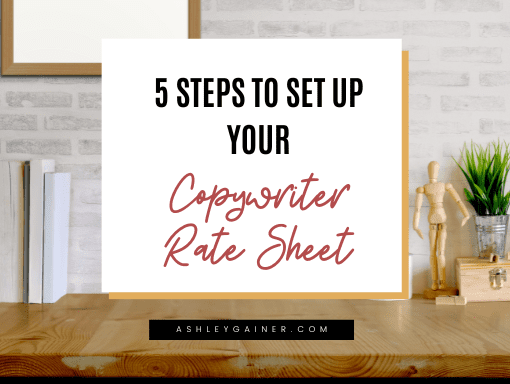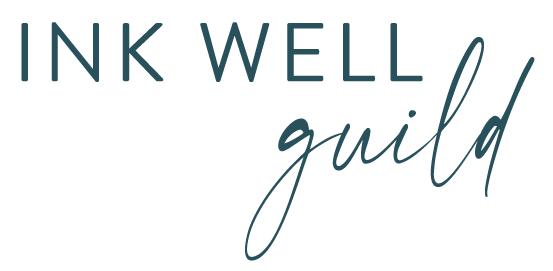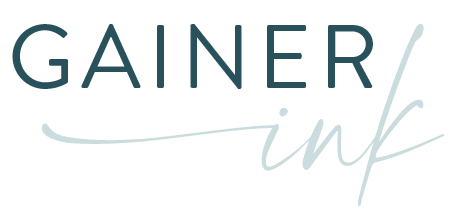The dreaded question… What do you charge for that? I have lots of workarounds for NOT answering that question when I’m on the spot and not totally sure what to say, but I also know it’s important to give a real number in some contexts. Thus, the copywriter rate sheet.
What is a Copywriter Rate Sheet?
So, what exactly IS a copywriter rate sheet?
Think about it as building yourself a tool to use internally, so that you know what your rates are for any given project that might come up.
It doesn’t have to be exactly what you charge, but can be set up as a reference sheet or guide. It’s really helpful to have your rate sheet handy when you feel on the spot as you get an inquiry. This way, if you want to give an actual number during that conversation, you have your copywriter rate sheet ready to go — you always have an answer.
Now that you know more about what it is, here’s my five-step framework to setting up your copywriter rate sheet so that you can be more professional and have faster answers.
Step 1. What is the purpose of your rate sheet?
The first thing that you do is get clear on the actual purpose of this document, which is to serve as a reference sheet for your eyes only.
You can make it public later, if you want to. You can put the information from it on your website, add it to your proposals, or make a link to it in your email signature.
But the reason it’s important to think of it as an internal document first is so that you can turn off all the brain chatter that will try to interfere when you get started. Things like, “oh, well, can I say that? oh, is this gonna bother my clients?”
All that stuff that we do to psych ourselves out of the actual test that we’re doing: don’t do that. This is just for your eyes. So, start with your draft, internal version.
Step 2. What services do you offer?
Write down anything and everything you’re willing to do (doesn’t just have to be writing) as a service.
You might put that you write emails, sales pages, landing pages, case studies, white papers, content upgrades, etc.
You can get even more specific. Instead of just “emails” split off the types of email sequences. For example, five-part nurture sequences, follow-up sequence, promo sequence, joint venture, affiliate, individual ongoing emails, and/or newsletters. For a blog post, which can be anywhere from 500 to 5,000 words, theoretically, you might want to group it into tiers — long blog post, short blog post, etc.
Don’t worry about pricing. Just come up with all the writing services that you are willing to offer.
You may find in your subsequent research that you come across other services you can offer. Depending on your skills, you could offer things like:
- proofreading
- editing
- doing tech hookups for the email sequences that you write
- designing and building out a landing page or a sales page
- building a website
- designing a website and writing the copy for it
- strategy sessions
- auditing courses
- managing social media (can include some or all of: writing captions, coming up with graphics, scheduling and posting, handling comments)
Step 3. What do you charge?
Now you can start listing your prices, after you have your full list of services.
First set any prices that you already feel confident charging or know what to charge. These could be things like a per word rate for your blog posts, or a per email rate. Maybe you have a monthly retainer package for social media management.
Write down all the prices that you know.
Step 4. Research and fill in
There will most likely be services that you’re not exactly sure what to charge.
Research what you don’t know
For those, begin researching the going rate for each service and how people usually charge (flat rate, word rate, or hourly, etc.).
What’s the hourly rate for a proofreader? How much should I charge for a sales page? There are many places you can look. Here are 3 links to start:
- Ed Gandia has a rate guide.
- AWAI has a Pricing Guide.
- The Editorial Freelancers Association has a writing and editing rate guide.
If you want opinions on your rate choices. I suggest that you come into my free Facebook group, The Ink Well Guild. You can ask, “Hey, what do I charge for this or this or this?” You’ll get some opinions. You’ll most likely get my opinion.
The other decision to make is if you want to charge a flat rate, per word rate, or an hourly rate. You can charge different things for different services. For example, I like to charge a flat rate based on word count for writing a blog post. But, if I’m editing, rewriting, or updating a blog post, I would typically price it by the hour, because it’s hard to predict from time to time or from project to project.
Fill in your rate sheet bit by bit
So bit by bit, you fill in your rate sheet. You may have inquiries where people ask if you can write things or provide services that you decide that you are open to doing. Maybe you’ll add those to your rate guide.
The rate guide is pretty dynamic, not something that you set today, and have as your rates for the rest of your life. There will be things you will add and remove from it. There will be things you are no longer willing to do.
The list of things I have removed from my rate sheet is long. At this point, the number of things I have removed would probably be larger than the number of things actually on my rate sheet.
In fact, I have the link to my Google doc with my internal rate guide in my bookmarks bar of my Chrome browser. Aside from being useful in conversations with clients, it also helps when I get questions from students. If it’s been a while since I’ve done something, I can look it up, see what my current rates are, and then extrapolate from that what my recommendation would be for someone at a different point in their career.
Step 5. Revisit your rates regularly
Aside from changing what services you provide on your rate sheet, you should also remember to update your rates. Set a calendar reminder to revisit your rates in six months. You could decide it’s time to bump things up, or not, but make it official to revisit your rates regularly.
A wonderful thing about having a copywriter rate sheet is that you don’t have to make up numbers, fly by the seat of your pants, or get caught up in insecurity about what to charge. You can trust that you’ve done the research into figuring out what the rates are when your emotions are even.
Later on, when you’re in what feels like a high pressure situation with a prospect, you can sidestep a lot of anxiety, because you’ve already done the math ahead of time. You’ve already set your rates.
When you have that kind of ease that keeps you from spinning out, you’re able to present yourself more professionally. When you can present yourself more professionally, you’re more inclined to get the work.
If you want to read more, be sure to check out my post on How And Why To Make A Freelance Writing Rate Guide.
Swipe MY copywriter rate sheet
Would you like to use MY copywriter rate sheet as your guide?
I’m sharing it here: Copy of Ashley Gainer’s Copywriter Rate Sheet
You can use it as a template for your own, until you have a better feel for exactly what services you are best at and what services are in demand. I’m rooting for you!




